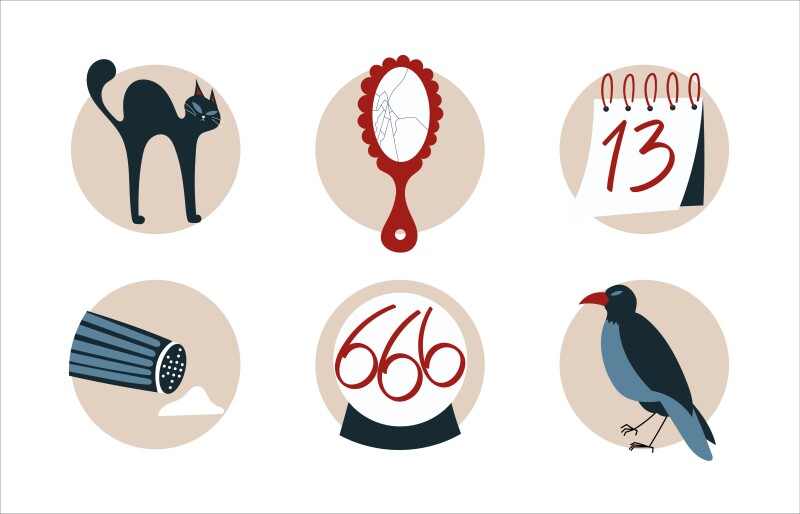Lifestyle
Unraveling the Origins of Spooky Superstitions Across Cultures

Superstitions surrounding black cats, Friday the 13th, and broken mirrors have long captured the public’s imagination. Understanding the origins of these beliefs reveals a complex tapestry woven from mythology, ancient civilizations, and religious history.
Black Cats: From Reverence to Bad Luck
The association of black cats with misfortune originated in Europe during the Middle Ages. Cats were mistakenly linked to witchcraft and deemed as demonic companions to witches. A significant turning point occurred in **1233**, when a papal decree from **Pope Gregory IX** intensified fears surrounding black cats, associating them with heretical rituals. This belief was further solidified during witch hunts and eventually crossed the Atlantic with early settlers, establishing a lasting superstition.
Interestingly, the negative perception of black cats is not universal. In ancient Egypt, black cats were revered and associated with the goddess **Bastet**. Similarly, in Japan, a black cat crossing a woman’s path is seen as a sign of good fortune in finding a suitor. Additionally, sailors historically considered a black cat aboard their ship a good omen, symbolizing a safe voyage.
Friday the 13th: A Day of Fear
The superstition surrounding Friday the 13th stems from various religious and historical narratives. In the Christian tradition, the Last Supper is often cited; there were **13** attendees, with **Judas**, the 13th guest, betraying **Jesus Christ**. Compounding this, Jesus was crucified on a Friday, making this combination particularly ominous, according to the **Library of Congress Blogs**.
The significance of this date is further reinforced by the mass arrest and execution of the **Knights Templar** by **King Philip IV of France** on **October 13, 1307**. This event has solidified the date’s reputation as unlucky. In Norse mythology, the mischief god **Loki** was an uninvited guest at a gathering of gods, leading to the death of **Balder**, another tragic association tied to the number 13.
The number itself has been viewed as unlucky for centuries, as it follows the “perfect” number 12, often associated with order and completion, such as **12 months** in a year or **12 zodiac signs**.
Broken Mirrors: Reflections of Bad Luck
The belief that breaking a mirror brings bad luck has its roots in ancient Roman culture. Romans held that mirrors reflected a person’s soul, and damaging one could harm the soul itself. A broken mirror was thought to trap the soul in a distorted reflection, leading to a **seven-year** period of misfortune, as suggested by the **University of South Carolina**.
This superstition was compounded by the belief that breaking a mirror disrespected the gods, potentially inviting their punishment. Over time, various remedies have emerged to counteract the bad luck associated with broken mirrors, including grinding the glass to dust, burying the pieces, or tossing them into a stream of water that flows south.
Two Mirrors: Portals to the Unknown
One particularly eerie superstition involves placing two mirrors facing each other, which is believed to create a “ghost portal.” This idea stems from the notion that mirrors can create infinite reflections, potentially trapping spirits or allowing paranormal entities to cross into our reality. Some cultures regard mirrors as “liminal” spaces—transitional areas between dimensions—enabling spirits to traverse from one realm to another.
This belief extends to the idea that the infinite reflections can disturb natural energy, possibly creating pathways for negative forces or confused spirits. Some variations even suggest that spirits can become trapped within the space between two facing mirrors, haunting those nearby.
These superstitions provoke curiosity and reflection on cultural beliefs surrounding luck and fate. Whether one subscribes to these beliefs or not, they continue to influence societal perceptions. What remains intriguing is how such narratives shape our understanding of luck and misfortune across various cultures.
-

 Politics1 week ago
Politics1 week agoDallin H. Oaks Assumes Leadership of Latter-day Saints Church
-

 Sports1 week ago
Sports1 week agoSteve Kerr Supports Jonathan Kuminga After Ejection in Preseason Game
-

 Lifestyle1 week ago
Lifestyle1 week agoDua Lipa Celebrates Passing GCSE Spanish During World Tour
-

 Business1 week ago
Business1 week agoTyler Technologies Set to Reveal Q3 2025 Earnings on October 22
-

 World1 week ago
World1 week agoD’Angelo, Iconic R&B Singer, Dies at 51 After Cancer Battle
-

 Science1 week ago
Science1 week agoChicago’s Viral ‘Rat Hole’ Likely Created by Squirrel, Study Reveals
-

 Entertainment1 week ago
Entertainment1 week agoZoe Saldana Advocates for James Cameron’s Avatar Documentary
-

 Lifestyle1 week ago
Lifestyle1 week agoKelsea Ballerini Launches ‘Burn the Baggage’ Candle with Ranger Station
-

 Health1 week ago
Health1 week agoRichard Feldman Urges Ban on Menthol in Cigarettes and Vapes
-

 Health1 week ago
Health1 week agoCommunity Unites for Seventh Annual Mental Health Awareness Walk
-

 Business1 week ago
Business1 week agoMega Millions Jackpot Reaches $600 Million Ahead of Drawings
-

 Business1 week ago
Business1 week agoMLB Qualifying Offer Jumps to $22.02 Million for 2024









